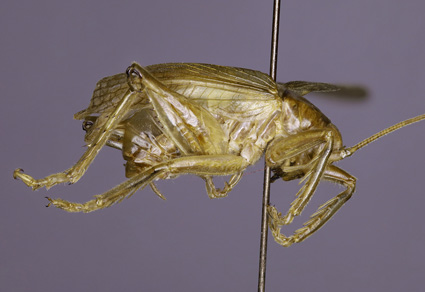Abstract
Astyloplatum luteolum n. gen. et n. sp., is described, as a new monospecific genus from the eastern slope of the Colombian Andes, of the middle and highlands of the departments of Boyacá and Santander. This new taxon is distinguished by its yellowish coloration and the lack of articulated stylli on the male subgenital plate; this character converges with several taxa unrelated to the tribe Gryllacridini in which Astyloplatum n. gen. is placed. The convergence of characters in gryllacridines, diversity, complement of the current classification, and the importance of the phallic complex for the delimitation of genera and species are discussed.
References
- Cadena-Castañeda, O.J. (2015) The phallic complex in Gryllotalpidae (Orthoptera: Gryllotalpoidea), and its generic implications. Zootaxa, 3981 (2), 264–274. https://doi.org/10.11646/zootaxa.3981.2.7 DOI: https://doi.org/10.11646/zootaxa.3981.2.7
- Cadena-Castañeda, O.J. (2019) A proposal towards classification of the Raspy Crickets (Orthoptera: Stenopelmatoidea: Gryllacrididae) with zoogeographical comments: An initial contribution to the higher classification of the Gryllacridines. Zootaxa, 4605 (1), 1–100. https://doi.org/10.11646/zootaxa.4605.1.1 DOI: https://doi.org/10.11646/zootaxa.4605.1.1
- Cadena-Castañeda, O.J., Quiroga, C., Arango, C.J. & Rodríguez, W. (2020a) Studies on raspy crickets: Magnumtergalis n. gen. a new gryllacrid genus of male prolonged terminalia (Orthoptera: Gryllacrididae) from Colombia. Zootaxa, 4896 (1), 123–130. https://doi.org/10.11646/zootaxa.4896.1.7 DOI: https://doi.org/10.11646/zootaxa.4896.1.7
- Cadena-Castañeda, O.J., Arango, C.J., Parra, O.N. & García García, A. (2020b) Studies on raspy crickets: New Triaenogryllacris species (Orthoptera: Gryllacrididae). Zootaxa, 4896 (2), 239–250. DOI: https://doi.org/10.11646/zootaxa.4896.2.5
- Cadena-Castañeda, O.J., Araujo-Peña, I.N., Rubiano-Guzmán, M. & Arango Díaz, C.J. (2021) Studies on raspy crickets: A new Andean Hyperbaenini genus (Orthoptera: Gryllacrididae: Hyperbaeninae). Zootaxa, 4969 (1), 183–190. https://doi.org/10.11646/zootaxa.4969.1.11 DOI: https://doi.org/10.11646/zootaxa.4969.1.11
- Chamorro-Rengifo, J. & Lopes-Andrade, C. (2014) The phallus in Tettigoniidae (Insecta: Orthoptera: Ensifera): revision of morphology and terminology, and discussion on its taxonomic importance and evolution. Zootaxa, 3815 (2), 151–199. https://doi.org/10.11646/zootaxa.3815.2.1 DOI: https://doi.org/10.11646/zootaxa.3815.2.1
- Cigliano, M.M., Braun, H., Eades, D.C. & Otte, D. (2023) Orthoptera Species File. Version 5.0/5.0. Available from: http://Orthoptera.SpeciesFile.org (accessed 26 April 2023)
- iNaturalist (2023) Available from https://www.inaturalist.org (accessed 26 April 2023)
- Ingrisch, S. (2018) New taxa and records of Gryllacrididae (Orthoptera, Stenopelmatoidea) from South East Asia and New Guinea with a key to the genera. Zootaxa, 4510 (1), 1–278. https://doi.org/10.11646/zootaxa.4510.1.1 DOI: https://doi.org/10.11646/zootaxa.4510.1.1
- Karny, H.H. (1937) Orthoptera Fam. Gryllacrididae, Subfamiliae Omnes. Genera Insectorum, 206, 1–317.
- Rentz, D.C.F. & John, B. (1990) Studies in Australian Gryllacrididae: taxonomy, biology, ecology and cytology. Invertebrate Taxonomy, 3 (8), 1053–1210. https://doi.org/10.1071/IT9891053 DOI: https://doi.org/10.1071/IT9891053


